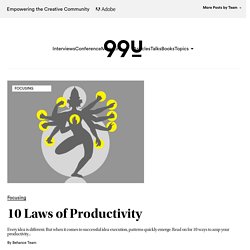

Twelve Things You Were Not Taught in School About Creative Thinking. 2382 516Share Synopsis Aspects of creative thinking that are not usually taught. 1.

You are creative. The artist is not a special person, each one of us is a special kind of artist. James Clear: How to Stop Procrastinating by Using the 'Two-Minute Rule' Recently, I've been following a simple rule that is helping me crush procrastination and making it easier for me to stick to good habits at the same time.

I want to share it with you today so that you can try it out and see how it works in your life. The best part? It's a simple strategy that couldn't be easier to use. Here's what you need to know. How to Stop Procrastinating With the "Two-Minute Rule" I call this little strategy the "Two-Minute Rule," and the goal is to make it easier for you to get started on the things you should be doing. Here's the deal: Most of the tasks that you procrastinate on aren't actually difficult to do -- you have the talent and skills to accomplish them -- you just avoid starting them for one reason or another.
The two-minute rule overcomes procrastination and laziness by making it so easy to start taking action that you can't say no. There are two parts to the two-minute rule... Part One: If it takes less than two minutes, then do it now. Try It Now. Pixar Cofounder Ed Catmull on Failure and Why Fostering a Fearless Culture Is the Key to Groundbreaking Creative Work. By Maria Popova Why the greatest enemy of creative success is the attempt to fortify against failure.

“Make New Mistakes. Make glorious, amazing mistakes. Make mistakes nobody’s ever made before,” Neil Gaiman urged in his commencement-address-turned-manifesto-for-the-creative life. “The chief trick to making good mistakes is not to hide them — especially not from yourself,” philosopher Daniel Dennett asserted in his magnificent meditation on the dignity and art-science of making mistakes. What makes Catmull, who created Pixar along with Steve Jobs and John Lasseter and is now president of Pixar Animation and Disney Animation, particularly compelling is his yin-yang balance of seeming opposites — he is incredibly intelligent in a rationally-driven way yet sensitive to the poetic, introspective yet articulate, has a Ph.D. in computer science but is also the recipient of five Academy Awards for his animation work.
Ed Catmull (Photograph by Deborah Coleman, Pixar) Donating = Loving. How To be so Productive You Can't Stand it. You might think that creatives as diverse as Internet entrepreneur Jack Dorsey, industrial design firm Studio 7.5, and bestselling Japanese novelist Haruki Murakami would have little in common.

In fact, the tenets that guide how they – and exceptionally productive creatives across the board – make ideas happen are incredibly similar. Here are 10 laws of productivity we’ve consistently observed among serial idea executors: 1. Break the seal of hesitation. A bias toward action is the most common trait we’ve found across the hundreds of creative professionals and entrepreneurs we’ve interviewed. 2. When our ideas are still in our head, we tend to think big, blue sky concepts. 3. Trial and error is an essential part of any creative’s life. To avoid ‘blue sky paralysis,’ pare your idea down to a small, immediately executable concept. Mind Tools - Management Training, Leadership Training and Career Training. Personal Goal Setting - Goal Setting Tools from MindTools.com - StumbleUpon.
Planning to Live Your Life Your Way Learn how to set effective personal goals.

Many people feel as if they're adrift in the world. They work hard, but they don't seem to get anywhere worthwhile. A key reason that they feel this way is that they haven't spent enough time thinking about what they want from life, and haven't set themselves formal goals. After all, would you set out on a major journey with no real idea of your destination? Goal setting is a powerful process for thinking about your ideal future, and for motivating yourself to turn your vision of this future into reality. The process of setting goals helps you choose where you want to go in life. Why Set Goals? Top-level athletes, successful business-people and achievers in all fields all set goals. By setting sharp, clearly defined goals, you can measure and take pride in the achievement of those goals, and you'll see forward progress in what might previously have seemed a long pointless grind.